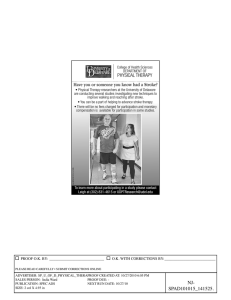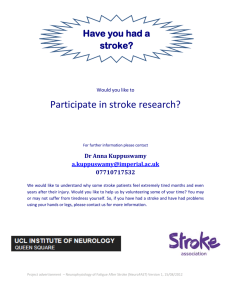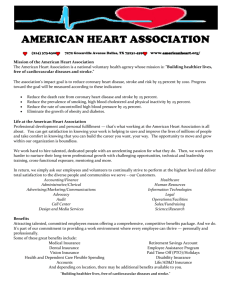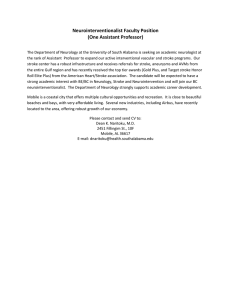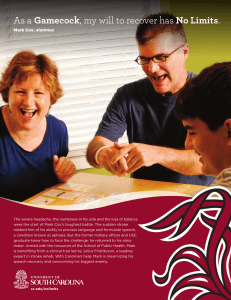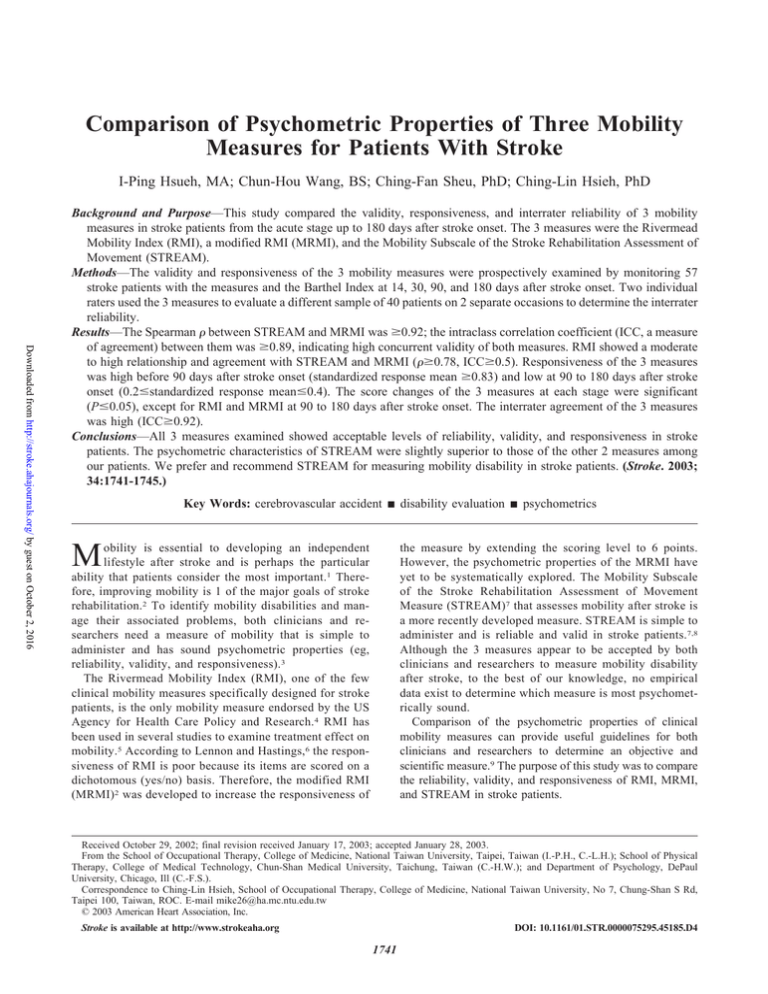
Comparison of Psychometric Properties of Three Mobility
Measures for Patients With Stroke
I-Ping Hsueh, MA; Chun-Hou Wang, BS; Ching-Fan Sheu, PhD; Ching-Lin Hsieh, PhD
Downloaded from http://stroke.ahajournals.org/ by guest on October 2, 2016
Background and Purpose—This study compared the validity, responsiveness, and interrater reliability of 3 mobility
measures in stroke patients from the acute stage up to 180 days after stroke onset. The 3 measures were the Rivermead
Mobility Index (RMI), a modified RMI (MRMI), and the Mobility Subscale of the Stroke Rehabilitation Assessment of
Movement (STREAM).
Methods—The validity and responsiveness of the 3 mobility measures were prospectively examined by monitoring 57
stroke patients with the measures and the Barthel Index at 14, 30, 90, and 180 days after stroke onset. Two individual
raters used the 3 measures to evaluate a different sample of 40 patients on 2 separate occasions to determine the interrater
reliability.
Results—The Spearman between STREAM and MRMI was ⱖ0.92; the intraclass correlation coefficient (ICC, a measure
of agreement) between them was ⱖ0.89, indicating high concurrent validity of both measures. RMI showed a moderate
to high relationship and agreement with STREAM and MRMI (ⱖ0.78, ICCⱖ0.5). Responsiveness of the 3 measures
was high before 90 days after stroke onset (standardized response mean ⱖ0.83) and low at 90 to 180 days after stroke
onset (0.2ⱕstandardized response meanⱕ0.4). The score changes of the 3 measures at each stage were significant
(Pⱕ0.05), except for RMI and MRMI at 90 to 180 days after stroke onset. The interrater agreement of the 3 measures
was high (ICCⱖ0.92).
Conclusions—All 3 measures examined showed acceptable levels of reliability, validity, and responsiveness in stroke
patients. The psychometric characteristics of STREAM were slightly superior to those of the other 2 measures among
our patients. We prefer and recommend STREAM for measuring mobility disability in stroke patients. (Stroke. 2003;
34:1741-1745.)
Key Words: cerebrovascular accident 䡲 disability evaluation 䡲 psychometrics
M
the measure by extending the scoring level to 6 points.
However, the psychometric properties of the MRMI have
yet to be systematically explored. The Mobility Subscale
of the Stroke Rehabilitation Assessment of Movement
Measure (STREAM)7 that assesses mobility after stroke is
a more recently developed measure. STREAM is simple to
administer and is reliable and valid in stroke patients.7,8
Although the 3 measures appear to be accepted by both
clinicians and researchers to measure mobility disability
after stroke, to the best of our knowledge, no empirical
data exist to determine which measure is most psychometrically sound.
Comparison of the psychometric properties of clinical
mobility measures can provide useful guidelines for both
clinicians and researchers to determine an objective and
scientific measure.9 The purpose of this study was to compare
the reliability, validity, and responsiveness of RMI, MRMI,
and STREAM in stroke patients.
obility is essential to developing an independent
lifestyle after stroke and is perhaps the particular
ability that patients consider the most important.1 Therefore, improving mobility is 1 of the major goals of stroke
rehabilitation.2 To identify mobility disabilities and manage their associated problems, both clinicians and researchers need a measure of mobility that is simple to
administer and has sound psychometric properties (eg,
reliability, validity, and responsiveness).3
The Rivermead Mobility Index (RMI), one of the few
clinical mobility measures specifically designed for stroke
patients, is the only mobility measure endorsed by the US
Agency for Health Care Policy and Research.4 RMI has
been used in several studies to examine treatment effect on
mobility.5 According to Lennon and Hastings,6 the responsiveness of RMI is poor because its items are scored on a
dichotomous (yes/no) basis. Therefore, the modified RMI
(MRMI)2 was developed to increase the responsiveness of
Received October 29, 2002; final revision received January 17, 2003; accepted January 28, 2003.
From the School of Occupational Therapy, College of Medicine, National Taiwan University, Taipei, Taiwan (I.-P.H., C.-L.H.); School of Physical
Therapy, College of Medical Technology, Chun-Shan Medical University, Taichung, Taiwan (C.-H.W.); and Department of Psychology, DePaul
University, Chicago, Ill (C.-F.S.).
Correspondence to Ching-Lin Hsieh, School of Occupational Therapy, College of Medicine, National Taiwan University, No 7, Chung-Shan S Rd,
Taipei 100, Taiwan, ROC. E-mail mike26@ha.mc.ntu.edu.tw
© 2003 American Heart Association, Inc.
Stroke is available at http://www.strokeaha.org
DOI: 10.1161/01.STR.0000075295.45185.D4
1741
1742
Stroke
July 2003
Methods
Subjects
Subjects were recruited from stroke patients consecutively admitted
to National Taiwan University Hospital between April 1 and December 31, 2001. Patients were included in the study if they met the
following criteria: (1) diagnosis (International Classification of
Diseases, ninth revision, clinical modification [ICD-9] codes) of
cerebral hemorrhage (ICD-9, 431) or cerebral infarction (ICD-9,
434), (2) first onset of stroke without other major disease and the
absence of a preexisting disability, (3) stroke onset within 14 days
before admission, (4) ability to follow instructions, (5) willingness to
participate in this study, and (6) residence in the greater Taipei area.
The clinical diagnosis of stroke was confirmed by neuroimaging
examination. Patients who suffered another stroke or had another
major disease during the follow-up period were excluded.
Procedures
Downloaded from http://stroke.ahajournals.org/ by guest on October 2, 2016
The study protocol consisted of 2 parts. The first part was a validity
and responsiveness study. The 3 mobility measures and the Barthel
Activities of Daily Living Index (BI)10 were administered to patients
at 14, 30, 90, and 180 days after stroke onset. The BI was used as the
external criterion to examine convergent and predictive validity.
Initial stroke severity was ascertained with the Canadian Neurological Scale11 applied retrospectively to medical records. Degrees of
responsiveness of the mobility measures were calculated from the
changes occurring between 14 to 30, 30 to 90, 90 to 180, 14 to 90,
and 14 to 180 days after stroke onset.
When necessary, patients were allowed to rest during the testing
protocol, which lasted ⬇1 hour. All of the above assessments were
made by occupational therapist A, according to previously published
standardized methods of administration.2,11–14
The second part of the protocol was an interrater reliability study.
Forty stroke patients at a rehabilitation unit participated in this part
of the study. The 3 mobility measures were administered separately
by 2 occupational therapists (A and B). To minimize the effects of
possible recovery, assessments were administered within a 24-hour
period according to a counterbalanced sequence. The therapists were
blinded to the results of each other’s assessments during the study
period.
Instruments
RMI, which covers a range of hierarchical activities from turning
over in bed to running, comprises 14 questions and 1 direct
observation.13 Each patient’s mobility performance is rated primarily
by interviewing the patients and/or their primary caregiver. The
highest score, 15, indicates the highest mobility status. Although
previous studies3,13,15 found that RMI had good psychometric properties in stroke patients, sample sizes in 2 of these studies were
modest (ⱕ23),13,15 limiting generalization of their results.
MRMI has 8 test items: turning over, changing from lying to
sitting, maintaining sitting balance, going from sitting to standing,
standing, transferring, walking indoors, and climbing stairs. Scores
of the MRMI range from 0 to 40. One main characteristic of the
MRMI is that patients are scored by direct observation of their
performance on the items. Lennon and Johnson2 have proposed that
the psychometric characteristics of the MRMI be examined further.
STREAM7 measures mobility after stroke by direct observation. It
contains 10 four-point items: rolling, bridging, going from supine to
sitting, changing from sitting to standing, standing, placing affected
foot onto first step, stepping backward, stepping to affected side,
walking 10 m, and walking down stairs. Scores of STREAM range
from 0 to 30. Although the reliability and validity of STREAM are
high in stroke patients,8,12 its responsiveness has not been reported.
The BI is a weighted scale of 10 items of basic activities of daily
living (ADL).10 The highest score, 100, indicates that the patient is
fully independent in physical function; the lowest score, 0, represents
a totally dependent, bedridden state. The reliability, validity, and
responsiveness of the BI are well established in stroke patients.16,17
Stroke severity at admission was determined by the Canadian
Neurological Scale as described by Goldstein and Chilukuri.11 The
score ranges from 0 to 11.5. This instrument has been shown to be
valid and reliable in assessing stroke severity.11,18
Statistical Analyses
A mobility measure should be able to reflect the whole range of
mobility disability after stroke. We calculated the floor and ceiling
effects, representing the percentage of subjects achieving the lowest
and highest scores possible, respectively. Floor and ceiling effects
exceeding 20% of sample size are considered to be significant,19
indicating that the measure can represent only a limited range of
mobility disability.
Concurrent validity is usually established by demonstrating a high
correlation or agreement between the measure and a gold standard.16
Because each of the 3 measures used has a different score range, the
scores from each measure were converted to a range of 0 to 100.16
The relationship and agreement between the 3 mobility measures at
4 time points were examined by use of the Spearman correlation
coefficient () and the intraclass correlation coefficient (ICC),
respectively.
The convergent validity of the mobility measures was assessed by
examining the relationships between the total scores of the mobility
measures and those of the BI at all 4 time points after stroke using
Spearman’s . The predictive validity of the mobility measures was
assessed by examining the associations between results of the
mobility measures at 3 time points (14, 30, and 90 days after stroke
onset) and those of the BI at 180 days after stroke onset using the
Spearman .
Responsiveness was examined with the standardized response
mean (SRM), 1 type of effect size. SRM was calculated by dividing
the mean change scores by the SD of the change score in the same
subjects. An effect size ⬎0.8 is usually considered large; 0.5 to 0.8,
moderate; and 0.2 to 0.5, small.20 Wilcoxon matched-pairs signedrank tests were performed to determine the statistical significance of
the change scores.
The interrater agreement on individual items of the mobility
measures was analyzed with the quadratic weighted statistic. The
interrater agreement of the total score of the mobility measures was
analyzed with the ICC statistic. The fixed effect of ICC model 321
was used to compute the ICC value for interrater reliability. Both
weighted and ICC values ⱖ0.80 indicate very good agreement;
0.60 to 0.79, good agreement; 0.40 to 0.59, moderate agreement;
0.20 to 0.39, fair agreement; and 0 to 0.2, poor agreement.18
Results
A total of 59 patients met the selection criteria. We excluded
157 patients because of stroke onset that was more than 14
days before admission, the patient living outside the greater
Taipei area, the occurrence of recurrent stroke, and/or communication difficulties. Two patients who met the selection
criteria declined to participate in the validity and responsiveness study. Of the remaining 57 patients, 43 completed the
follow-up at 180 days after stroke. The Canadian Neurological Scale scores showed that patients had a broad range of
severity (from mild to severe stroke) at admission. In addition, the BI scores indicated that patients were severely
disabled at baseline. Nonetheless, 42% of the patients were
nearly independent at 180 days after stroke onset (BI ⱖ95).
Characteristics of the study sample are presented in Table 1.
The interquartile score range of the RMI at baseline was
quite limited (Table 1). Furthermore, Table 2 shows that,
except for RMI, none of the mobility measures exhibited
significant floor or ceiling effects at the 4 time points after
stroke. These results indicate that MRMI and STREAM
demonstrated acceptable distribution from the acute stage up
to 180 days after stroke onset.
Hsueh et al
TABLE 1.
Psychometric Properties of 3 Mobility Measures
1743
Characteristics of the Stroke Patients
Characteristic
43 Patients Who Completed 14 Patients Who Failed
the Study
to Complete the Study
All 57 Patients
Sex, M/F, n
Mean (SD) age, y
34/23
26/17
8/6
64.2 (11.5)
63.6 (11.4)
65.9 (12.0)
Diagnosis, n (%)
Cerebral hemorrhage
18 (32)
13 (30)
5 (36)
Cerebral infarction
39 (68)
30 (70)
9 (64)
Side of lesion, right/left, n
Canadian Neurological Score at admission,
median (interquartile range)
29/28
21/22
8/6
7 (4.5–8)
7 (4.5–8.5)
5.5 (4–8)
At 14 days after stroke onset, median
(interquartile range)
RMI score
Downloaded from http://stroke.ahajournals.org/ by guest on October 2, 2016
2 (0–5)
2 (0–5)
1 (0–2)
MRMI score
23 (13–31)
25 (15–32)
20 (9–25)
STREAM score
14 (7–21)
15 (8–21)
10 (5–18)
BI score
30 (15–50)
30 (15–55)
30 (15–45)
Table 3 shows that the correlation (ⱖ0.92) and agreement
(ICCⱖ0.89) between STREAM and MRMI were high, indicating that both measures had high concurrent validity. RMI
showed moderate to high concurrent validity (ⱖ0.78,
ICCⱖ0.50) when evaluated against STREAM and MRMI.
Table 4 shows that the 3 mobility measures had high
convergent validity (ⱖ0.72) and acceptable predictive validity (ⱖ0.5).
The 3 mobility measures were highly responsive in detecting changes before 90 days after stroke onset (14 to 30 days,
SRMⱖ1.14; 30 to 90 days, SRMⱖ0.83; Table 5). At 90 to
180 days after stroke onset, the levels of responsiveness of
these measures, as expected, were low (0.2ⱕSRMⱕ0.4). The
changes shown by the 3 measures at each stage were all
significant (P⬍0.05), except for those shown by RMI and
MRMI at 90 to 180 days after stroke onset (P⬎0.14).
Forty patients participated in the interrater reliability study.
This sample consisted of 19 men and 21 women with a mean
age of 63 years (SD, 10.2 years). The medians of the
weighted statistic for each item of RMI, MRMI, and
STREAM were 0.71 (range, 0.37 to 0.94), 0.72 (range, 0.47
to 0.9), and 0.81 (range, 0.55 to 0.89), respectively, indicating
generally acceptable interrater agreement on the item level.
Four RMI items, 2 MRMI items, and 1 STREAM item had
fair to moderate agreement (0.37ⱕⱕ0.6). The ICCs for the
total scores of RMI, MRMI, and STREAM were 0.92 (95%
confidence interval [CI], 0.84 to 0.96), 0.95 (95% CI, 0.90 to
0.97), and 0.97 (95% CI, 0.95 to 0.99), respectively, indicating excellent total score agreement.
Discussion
A simple and psychometrically sound mobility measure
enables both clinicians and researchers to identify, monitor,
and manage mobility disability after stroke.3,9 This study is
the first to compare the psychometric properties of the RMI,
MRMI, and STREAM mobility measures in stroke patients
concurrently and systematically. In addition, patients in the
study were monitored at 4 specific time points after stroke for
an extended period (up to 180 days after stroke onset) to
evaluate how appropriate these measures were for use at
different recovery stages after stroke. The findings of this
study can provide information useful for the selection of
mobility measures for both clinicians and researchers.
The score distributions of the measures of the study sample
should not exhibit severe ceiling or floor effects. We found
that all 3 mobility measures demonstrated acceptable distributions from the acute stage up to 180 days after stroke onset,
except for RMI, which at 14 days after stroke onset showed
a limited score range and a notable floor effect. These results
indicate that the RMI might not adequately characterize
patients’ mobility functions in the early stages of stroke,
especially for patients with severe disabilities.
The validity of the 3 mobility measures has been reported
in previous studies.2,3,8,12,13 However, given the notable heterogeneity of stroke effects, comparison with previous results
TABLE 2. Ceiling and Floor Effects of the 3 Mobility Measures and the BI at 4 Time Points
After Stroke
RMI, n (%)
MRMI, n (%)
STREAM, n (%)
BI, n (%)
Time After
Stroke, d
Floor
Ceiling
Floor
Ceiling
Floor
Ceiling
Floor
14 (n⫽57)
23 (40.4)
0 (0)
0 (0)
0 (0)
0 (0)
0 (0)
5 (8.8)
0 (0)
30 (n⫽54)
6 (11.1)
2 (3.7)
0 (0)
3 (5.6)
0 (0)
2 (3.7)
2 (3.7)
5 (9.3)
90 (n⫽44)
1 (2.3)
3 (6.8)
0 (0)
6 (13.6)
0 (0)
6 (13.6)
0 (0)
8 (18.2)
180 (n⫽43)
0 (0)
2 (4.7)
0 (0)
7 (16.3)
0 (0)
7 (16.3)
0 (0)
13 (30.2)
Ceiling
1744
Stroke
July 2003
TABLE 3. Concurrent Validity of the 3 Mobility Measures at 4
Time Points After Stroke
RMI vs MRMI
RMI vs STREAM
MRMI vs STREAM
Time After
Stroke, d
ICC
ICC
14 (n⫽57)
0.78
0.50
0.69
0.59
0.95
30 (n⫽54)
0.90
0.59
0.87
0.71
90 (n⫽44)
0.90
0.53
0.82
0.68
180 (n⫽43)
0.93
0.55
0.85
0.68
SRM
ICC
Time After
Stroke, d
RMI MRMI STREAM
0.94
14 –30 (n⫽51)
1.14 1.31
0.95
0.95
30–90 (n⫽43)
0.86 0.83
0.93
0.89
90–180 (n⫽43) 0.24 0.20
0.92
0.92
14–90 (n⫽43)
Downloaded from http://stroke.ahajournals.org/ by guest on October 2, 2016
was difficult because they were not examined in the same
group of patients. The validity of the 3 measures was first
compared in a cohort of patients in this study. We found that
STREAM and MRMI had high concurrent, convergent, and
predictive validity, whereas RMI was not highly correlated
with either STREAM or MRMI. It is of note that the RMI
score was retrieved mainly via interview, whereas the
STREAM and MRMI scores were based on direct observation of a patient’s performance. Patients may overstate their
functional abilities.22 Our results suggest that among our
patients, STREAM and MRMI were more valid measures of
mobility after stroke than RMI. However, the differences in
validity between the 3 measures may not be statistically
significant.
Responsiveness is important for any measurement tool
designed to measure change over time.23 Nonetheless, the
responsiveness of most mobility measures has yet to be
examined. The 3 mobility measures were highly responsive in
detecting changes before 90 days after stroke onset. All
changes in the 3 measures at each stage were significant,
except for the RMI and MRMI at 90 to 180 days after stroke
onset. According to the present results, STREAM was
slightly more responsive than the other 2 measures. Responsiveness of the 3 measures was, as expected, low at later
stages of recovery (90 to 180 days after stroke onset). One
possible explanation is that patients’ improvements in mobility had reached a plateau after 90 days after stroke onset.
Moreover, balance, motor, and ADL functions showed only
minor improvement after 90 days after stroke onset.24,25
Another possible explanation is that these 3 mobility measures lack items sensitive enough to detect change ⬎90 days
after stroke onset.
Interestingly, MRMI was no more responsive than RMI,
despite the fact that MRMI, with more scoring levels, was
TABLE 4. Convergent Validity and Predictive Validity of the 3
Mobility Measures at 4 Time Points After Stroke
Convergent Validity* ()
TABLE 5. Responsiveness of the 3 Mobility Measures and the
BI at Different Stages of Stroke Recovery
Predictive Validity† ()
Time After
Stroke, d
RMI
MRMI
STREAM
RMI
MRMI
STREAM
14 (n⫽57)
0.72
0.86
0.80
0.50
0.53
0.54
30 (n⫽54)
0.88
0.89
0.87
0.57
0.65
0.67
90 (n⫽44)
0.86
0.88
0.82
0.74
0.83
0.81
180 (n⫽43)
0.88
0.82
0.76
䡠䡠䡠
䡠䡠䡠
䡠䡠䡠
*Relationships between the total score of the mobility measures with that of
the BI at 4 time points after stroke.
†Relationships between the results of the mobility measures at 3 time points
(14, 30, and 90 d after stroke) and that of the BI at 180 d after stroke.
1.17
Wilcoxon z
BI
RMI MRMI STREAM
BI
1.51 5.59* 6.14*
6.02*
0.95
1.07 4.47* 4.91*
4.95*
4.99*
0.40
0.35 1.47
2.23†
2.19†
1.15
6.02*
1.67 1.56
1.61
2.09 5.65* 5.70*
5.72*
5.78*
14–180 (n⫽43) 1.94 1.53
1.65
2.01 5.65* 5.53*
5.57*
5.68*
*P⬍0.001; †P⬍0.05.
revised from RMI to make it more responsive.2 Some recent
studies have demonstrated that an increase in the number of
items or grading levels does not necessarily improve the
responsiveness or difference detection between patient
groups of mobility measures,26 balance measures,24 and ADL
measures.16,27,28 These results support the argument that
selection of a measurement tool should be based on empirical
evidence, not on clinical opinion.27
Interrater agreement on individual items of mobility measures has rarely been examined. The interrater agreement of
STREAM was high for individual items and the total scores.
Although the total score interrater agreement of the RMI and
MRMI was high, at least 2 items of both measures demonstrated only fair to moderate agreement between raters. These
findings indicate that the interrater reliability of STREAM is
slightly higher than that of RMI and MRMI.
Some mobility measures were not selected for comparison
in this study. For example, the gait speed test (eg, 10-m
walking speed test and 6-minute walking distance) is commonly used to measure mobility after stroke in both clinical
and research settings. However, the gait speed test is not
relevant for all patients with stroke. Mobility, by nature, is
complex and multifactorial, whereas the gait speed test
simply reflects 1 unique and specific dimension of mobility.
Furthermore, the speed test cannot be used for the patients
without the ability to walk. On the other hand, the 3 mobility
measures used in this study measure patients’ performance on
some tasks that reflect the multifactorial nature of mobility.
Furthermore, the 3 mobility measures examined in this study
are feasible for assessing most stroke patients, including those
with very poor mobility.
A limitation of the present study is that the intrarater
reliability of the measures was not examined. We found a
high interrater reliability of the measures. Therefore, the
intrarater reliability of the 3 measures might not be an issue
of great concern. Another limitation is that the sample size in
this study was not large enough to further analyze the data
according to type or severity of stroke. Because the type of
stroke or level of severity could affect the results of these
measures, further studies with larger sample sizes are necessary to analyze these effects on the psychometric characteristics of the measures. Furthermore, the psychometric properties of STREAM appeared to be slightly better than those of
the other 2 measures (eg, RMI showed a notable floor effect
in the early stages of stroke; the score changes of RMI and
MRMI at 90 to 180 days after stroke onset were not
Hsueh et al
significant). However, the psychometric differences among
the 3 measures may not be statistically significant.
In summary, the 3 mobility measures examined demonstrated acceptable levels of reliability, validity, and responsiveness among our stroke patients. The psychometric characteristics of STREAM were slightly superior to those of
RMI and MRMI. We prefer and recommend STREAM for
assessing mobility disability after stroke in both clinical and
research settings.
Acknowledgment
This study was supported by research grants from the National
Science Council (NSC 91-2314-B-002-353 and NSC
91-2314-B-002-354).
References
Downloaded from http://stroke.ahajournals.org/ by guest on October 2, 2016
1. Chiou I, Burnett CN. Values of activities of daily living: a survey of
stroke patients and their home therapists. Phys Ther. 1985;65:901–906.
2. Lennon S, Johnson L. The modified Rivermead Mobility Index: validity
and reliability. Disabil Rehabil. 2000;22:833– 839.
3. Hsieh CL, Hsueh IP, Mao HF. Validity and responsiveness of the Rivermead Mobility Index in stroke patients. Scand J Rehabil Med. 2000;
32:140 –142.
4. Gresham G, Duncan P, Stason W. Post-Stroke Rehabilitation:
Assessment, Referral, and Patient Management: Quick Reference Guide
Number 16. Rockville, Md: US Agency for Health Care Policy and
Research. AHCPR publication No. 95-0663, 1995.
5. Forlander DA, Bohannon RW. Rivermead Mobility Index: a brief review
of research to date. Clin Rehabil. 1999;13:97–100.
6. Lennon S, Hastings M. Key physiotherapy indicators for quality of stroke
care. Physiotherapy. 1996;82:655– 664.
7. Daley K, Mayo N, Danys I, Cabot R, Wood-Dauphinee S. The Stroke
Rehabilitation Assessment of Movement (STREAM): refining and validating the content. Physiother Can. 1997;49:269 –278.
8. Wang CH, Hsieh CL, Dai MH, Chen CH, Lai YF. Inter-rater reliability
and validity of the Stroke Rehabilitation Assessment of Movement
(STREAM) instrument. J Rehabil Med. 2002;34:20 –24.
9. Spilg EG, Martin BJ, Mitchell SL, Aitchison TC. A comparison of
mobility assessments in a geriatric day hospital. Clin Rehabil. 2001;15:
296 –300.
10. Mahoney F, Barthel D. Functional evaluation: the Barthel Index. Md State
Med J. 1965;14:61– 65.
11. Goldstein LB, Chilukuri V. Retrospective assessment of initial stroke
severity with the Canadian Neurological Scale. Stroke. 1997;28:
1181–1184.
Psychometric Properties of 3 Mobility Measures
1745
12. Daley K, Mayo N, Wood-Dauphinee S. Reliability of scores on the Stroke
Rehabilitation Assessment of Movement (STREAM) measure. Phys
Ther. 1999;79:8 –19.
13. Collen FM, Wade DT, Robb GF, Bradshaw CM. The Rivermead Mobility
Index: a further development of the Rivermead motor assessment. Int
Disabil Stud. 1991;13:50 –54.
14. Wade DT, Collin C. The Barthel ADL Index: a standard measure of
physical disability? Int Disabil Stud. 1988;10:64 – 67.
15. Green J, Forster A, Young J. A test-retest reliability study of the Barthel
Index, the Rivermead Mobility Index, the Nottingham Extended
Activities of Daily Living Scale and the Frenchay Activities Index in
Stroke Patients. Disabil Rehabil. 2001;23:670 – 676.
16. Hsueh IP, Lin JH, Jeng JS, Hsieh CL. Comparison of the psychometric
characteristics of the Functional Independence Measure, 5 item Barthel
Index, and 10 item Barthel Index in patients with stroke. J Neurol
Neurosurg Psychiatry. 2002;73:188 –190.
17. Hsueh IP, Lee MM, Hsieh CL. Psychometric characteristics of the Barthel
Activities of Daily Living Index in stroke patients. J Formos Med Assoc.
2001;100:526 –532.
18. Bushnell CD, Johnston DC, Goldstein LB. Retrospective assessment of
initial stroke severity: comparison of the NIH Stroke Scale and the
Canadian Neurological Scale. Stroke. 2001;32:656 – 660.
19. Holmes WC, Shea JA. Performance of a new, HIV/AIDS-targeted quality
of life (HAT-QoL) instrument in asymptomatic seropositive individuals.
Qual Life Res. 1997;6:561–571.
20. Cohen J. Statistical Power Analysis for the Behavioral Sciences.
Hillsdale, NJ: Lawrence Erlbaum Associates; 1988.
21. Shrout P, Fleiss J. Intraclass correlations: uses in assessing rater reliability. Psychol Bull. 1979;86:420 – 428.
22. Dorman PJ, Waddell F, Slattery J, Dennis M, Sandercock P. Are proxy
assessments of health status after stroke with the EuroQol questionnaire
feasible, accurate, and unbiased? Stroke. 1997;28:1883–1887.
23. Guyatt G, Walter S, Norman G. Measuring change over time: assessing
the usefulness of evaluative instruments. J Chronic Dis. 1987;40:
171–178.
24. Mao HF, Hsueh IP, Tang PF, Sheu CF, Hsieh CL. Analysis and comparison of the psychometric properties of three balance measures for
stroke patients. Stroke. 2002;33:1022–1027.
25. Jorgensen HS, Nakayama H, Raaschou HO, Vive-Larsen J, Stoier M,
Olsen TS. Outcome and time course of recovery in stroke, II: time course
of recovery: the Copenhagen Stroke Study. Arch Phys Med Rehabil.
1995;76:406 – 412.
26. Rossier P, Wade DT. Validity and reliability comparison of 4 mobility
measures in patients presenting with neurologic impairment. Arch Phys
Med Rehabil. 2001;82:9 –13.
27. Hobart JC, Thompson AJ. The five item Barthel Index. J Neurol Neurosurg Psychiatry. 2001;71:225–230.
28. Wallace D, Duncan PW, Lai SM. Comparison of the responsiveness of
the Barthel Index and the Motor Component of the Functional Independence Measure in stroke: the impact of using different methods for
measuring responsiveness. J Clin Epidemiol. 2002;55:922–928.
Comparison of Psychometric Properties of Three Mobility Measures for Patients With
Stroke
I-Ping Hsueh, Chun-Hou Wang, Ching-Fan Sheu and Ching-Lin Hsieh
Downloaded from http://stroke.ahajournals.org/ by guest on October 2, 2016
Stroke. 2003;34:1741-1745; originally published online May 29, 2003;
doi: 10.1161/01.STR.0000075295.45185.D4
Stroke is published by the American Heart Association, 7272 Greenville Avenue, Dallas, TX 75231
Copyright © 2003 American Heart Association, Inc. All rights reserved.
Print ISSN: 0039-2499. Online ISSN: 1524-4628
The online version of this article, along with updated information and services, is located on the
World Wide Web at:
http://stroke.ahajournals.org/content/34/7/1741
Permissions: Requests for permissions to reproduce figures, tables, or portions of articles originally published
in Stroke can be obtained via RightsLink, a service of the Copyright Clearance Center, not the Editorial Office.
Once the online version of the published article for which permission is being requested is located, click
Request Permissions in the middle column of the Web page under Services. Further information about this
process is available in the Permissions and Rights Question and Answer document.
Reprints: Information about reprints can be found online at:
http://www.lww.com/reprints
Subscriptions: Information about subscribing to Stroke is online at:
http://stroke.ahajournals.org//subscriptions/

